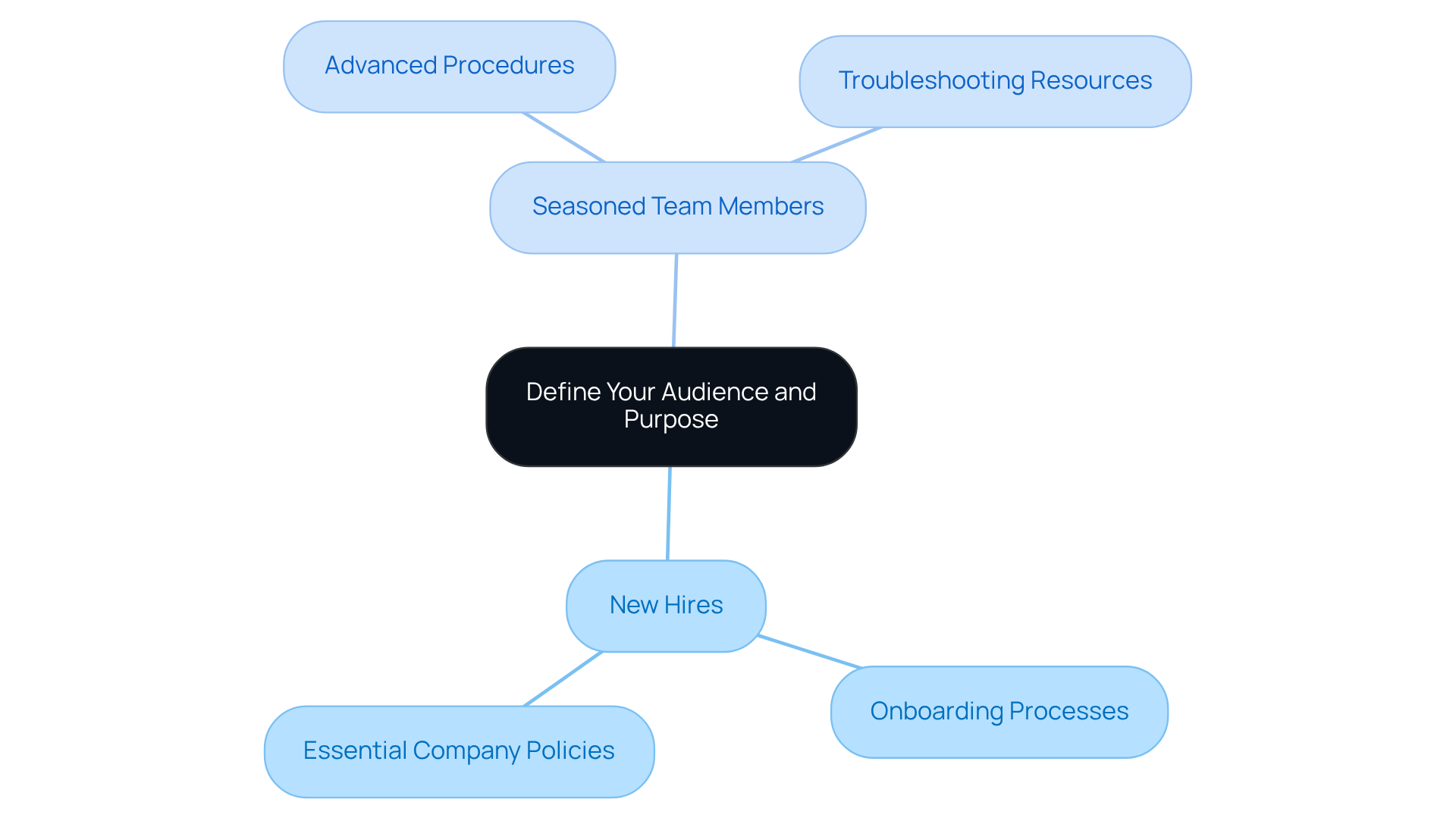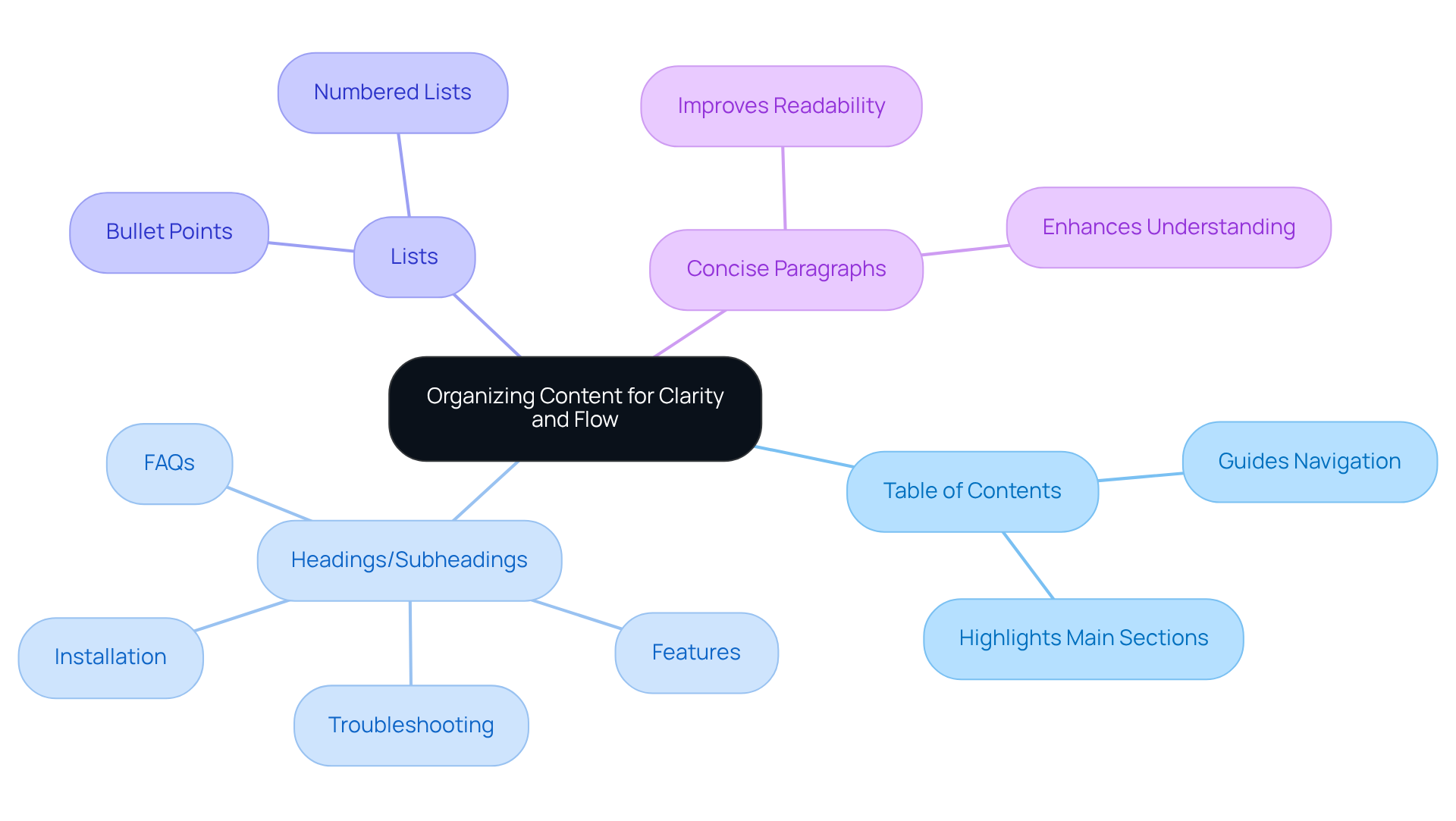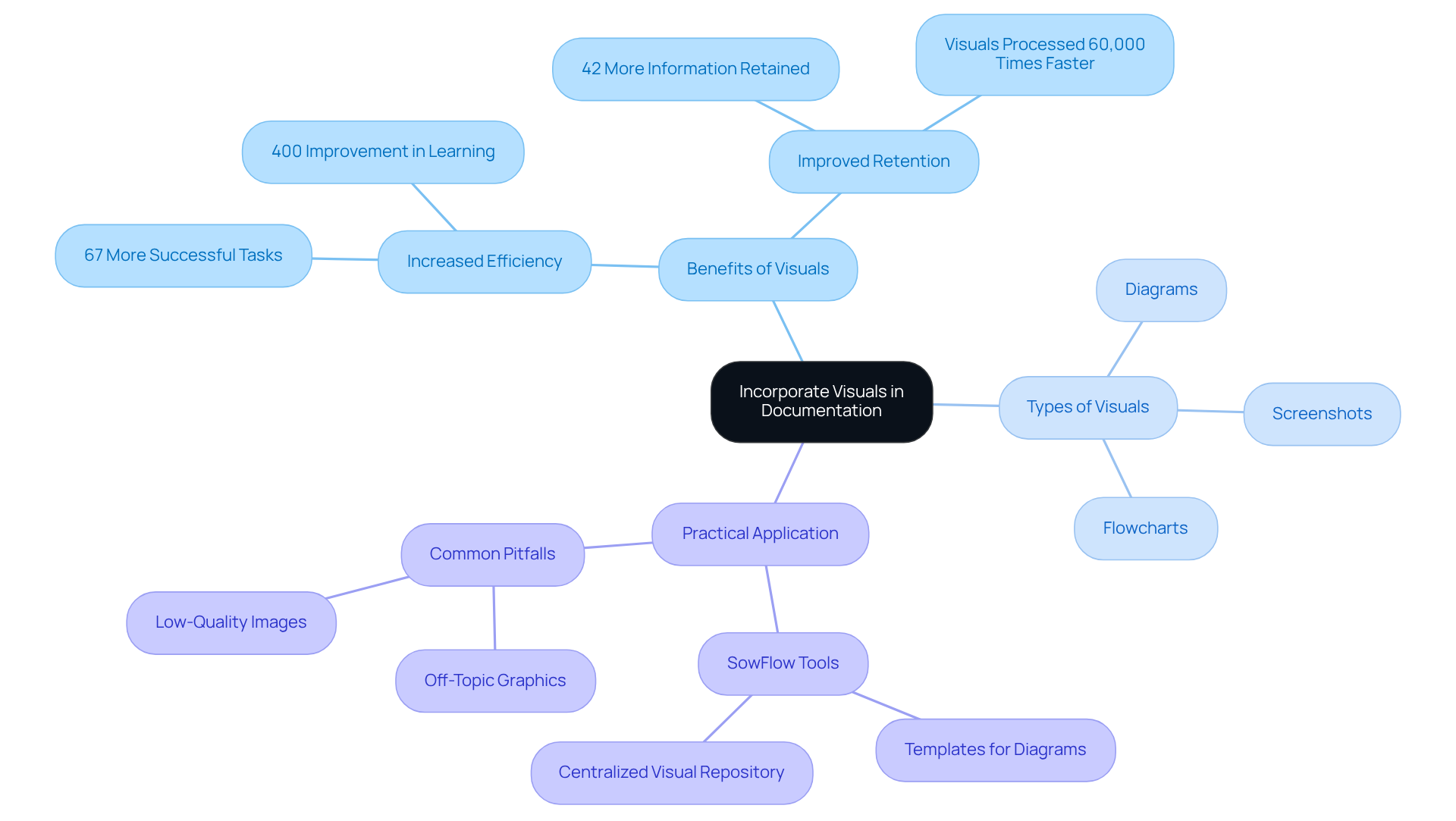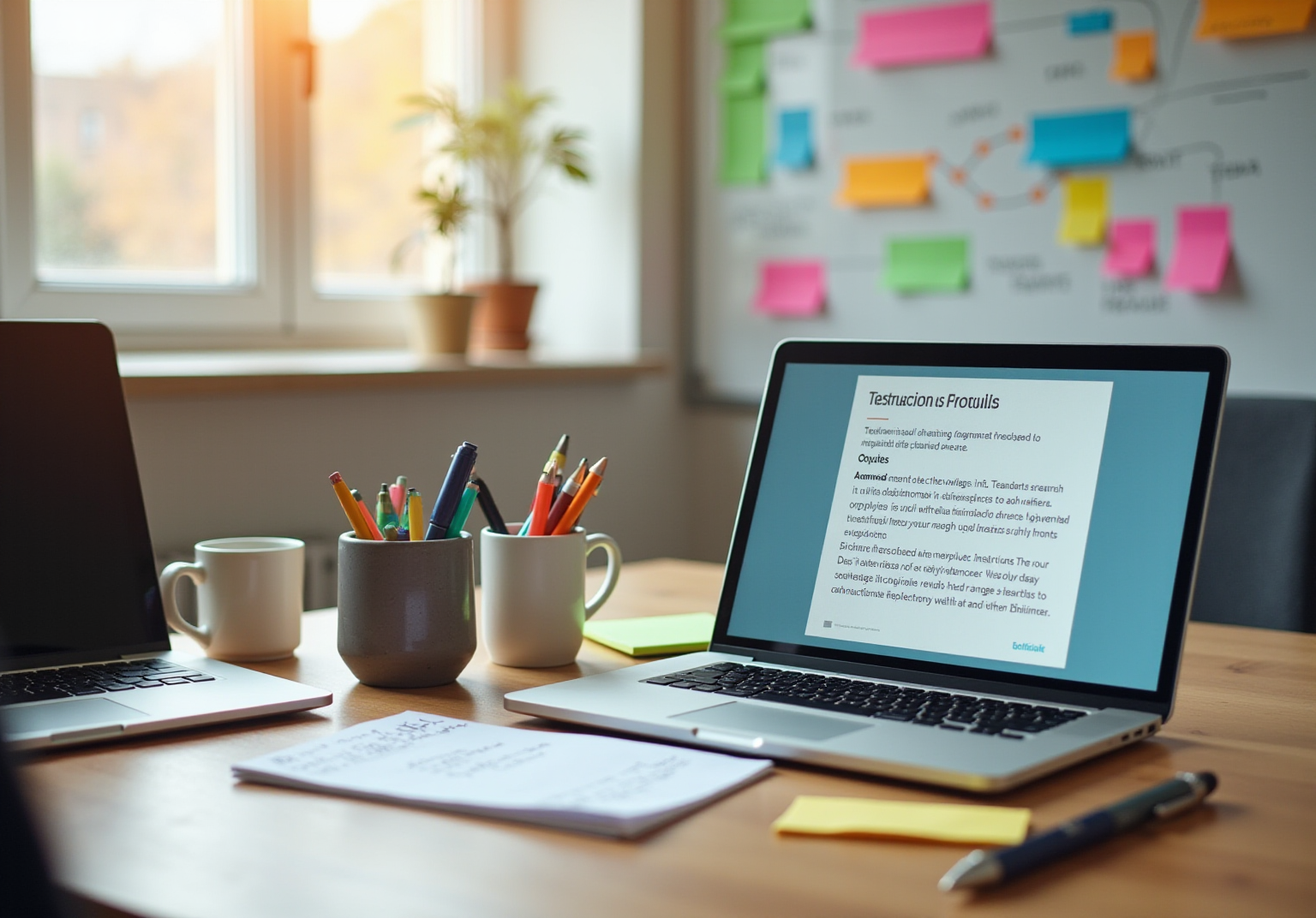
Process Improvement through Documentation
|
October 16, 2025
|
4 Step-by-Step Guide Examples to Enhance Documentation Effectiveness
Overview
You might be wondering how to make your documentation more effective. Well, this article lays out a simple four-step guide that’s all about enhancing your documentation game!
- First up, it’s crucial to identify your audience. Knowing who you’re writing for can really make a difference in how your message is received.
- Next, organizing your content is key—nobody likes a jumbled mess, right?
- Now, let’s dive into incorporating visuals. They’re not just pretty pictures; they can significantly boost comprehension and retention.
- Finally, establishing a review cycle ensures that your documents stay relevant and clear over time.
Each of these steps comes with practical strategies and evidence, making it easier for you to tailor your documents to meet audience needs and keep them engaged. So, are you ready to elevate your documentation skills?
Key Highlights:
- Identify your audience and their needs to tailor documentation effectively, enhancing engagement and satisfaction.
- Organise content logically with a clear table of contents, headings, and bullet points to improve clarity and navigation.
- Incorporate visuals like diagrams and screenshots to illustrate complex concepts, boosting understanding and retention.
- Establish a regular review cycle for documentation to ensure ongoing relevance and accuracy, improving operational efficiency.
- Seek feedback from users during reviews to identify areas for improvement and maintain the effectiveness of the records.
Introduction
You know, effective documentation really is the backbone of any successful organization. Yet, many of us struggle to create materials that truly resonate with our audience. By focusing on what users really need and using some smart strategies, documentation can shift from being just a formality to becoming a powerful tool for engagement and efficiency.
But here’s a question for you: how can organizations make sure their guides stay relevant and impactful in such a fast-paced world? In this article, we’ll explore four essential steps to boost documentation effectiveness, offering you some actionable insights that can elevate the quality and usefulness of records in various contexts.
Define Your Audience and Purpose
To produce effective records, you might be wondering where to start. It’s all about understanding your audience and their specific needs! Think about their skill level, the context in which they'll use the materials, and what you want them to achieve. For instance, if your audience is made up of new hires, your documentation should really focus on onboarding processes and essential company policies. On the flip side, if you’re addressing seasoned team members, you can dive into advanced procedures or troubleshooting resources.
By pinpointing your audience and purpose, you can tailor your content to be more relevant and useful, which boosts engagement and satisfaction. And here’s a fun fact: with SowFlow's rapid record-keeping solution, creating guides that meet these needs is a breeze—you can do it with just a single command! This not only streamlines the onboarding process but also nurtures a culture of effective knowledge sharing within your organization. Plus, it helps ensure that your documentation stays fresh and relevant in our fast-paced business world. So, are you ready to elevate your documentation game?

Organize Content for Clarity and Flow
You might be wondering why arranging content logically is so important. Well, it’s all about ensuring clarity and improving understanding! With SowFlow's manual creation tools, you can kick things off with a clearly defined table of contents that highlights the main sections of your document. This way, you’re guiding everyone through the material effortlessly.
Think about using headings and subheadings to break down complex information into bite-sized pieces. For example, when you're documenting a software application, you can create clear sections using step-by-step guide examples such as:
- Installation
- Features
- Troubleshooting
- FAQs
This approach not only helps users navigate the content but also gives them quick access to the specific information they need, empowering teams to find what they require right away.
And let’s not forget about bullet points, numbered lists, and concise paragraphs—they really amp up readability! SowFlow's solution makes it super easy to update and revise your documents, ensuring that everything stays relevant in our fast-paced business world. With just a single command, you can tap into the wisdom of your documentation, making it a breeze to find answers. Research shows that a well-structured document can really boost comprehension, allowing readers to absorb information more effectively. By adopting this structured approach with SowFlow, you can cut down on frustration and enhance overall efficiency, making it simpler for teams to locate the information they need without any unnecessary delays.

Incorporate Visuals and Real-World Examples
You might be wondering how to make your documentation more effective. Well, integrating visuals like diagrams, screenshots, and flowcharts can really boost your efficiency, especially when you're using SowFlow's guide creation tools. Visuals are fantastic for illustrating complex processes and concepts that text alone might struggle to convey. Did you know that studies show individuals accomplish tasks 67% more effectively when guidelines include visuals like screenshots or videos? It’s pretty impressive! Plus, real-world examples help contextualize the information, showing how it applies in practice.
This approach not only supports understanding but also helps you connect the material to your own experiences, making it feel more relevant and practical. And here’s another eye-opener: studies indicate that people retain 42% more information when visuals are involved compared to just text. This really underscores the importance of incorporating effective visual elements into your user guides. With SowFlow, you can easily tweak and adjust your materials, ensuring that your visuals remain clear and directly related to the content.
Consider using SowFlow's templates to create diagrams that clarify intricate concepts. The platform makes it a breeze to standardize records, which can significantly enhance team efficiency. However, watch out for common pitfalls! Using off-topic graphics or low-quality images can confuse learners instead of helping them. By strategically incorporating these visuals with SowFlow's tools, your materials become not only more engaging but also a powerful resource for enhancing user understanding and operational efficiency. Now, let’s dive into how you can start using these tips today!

Review and Update Guides for Ongoing Relevance
You might be wondering how to keep your records effective. Well, establishing a regular review cycle is key—ideally, you want to do this quarterly or biannually. This process should involve checking the significance and accuracy of your content, and it’s a great idea to get input from team members who actually use the materials. Their feedback can shine a light on areas that need updates or improvements.
Now, as processes and technologies evolve, it’s crucial to update your records swiftly to reflect those changes. For example, when a software application gets an upgrade, you’ll want to adjust the corresponding user guides to include new features or modified workflows. By prioritizing ongoing relevance, you not only build trust in your records but also ensure they continue to serve their intended purpose effectively.
Regular evaluations can really boost the quality of your records. Organizations that maintain effective records through systematic reviews often see improved operational efficiency and less frustration among employees. In fact, companies that adopt structured documentation practices can significantly reduce productivity losses tied to outdated or inaccurate information. This ultimately creates a more agile and responsive work environment. So, why not start thinking about your own documentation challenges and how you can tackle them?

Conclusion
You know, effective documentation is key to helping everyone understand things better and boosting how smoothly organizations run. By keeping the audience and purpose in mind, organizing information logically, adding visuals, and regularly reviewing what’s out there, documentation can really become a game changer for communication and sharing knowledge. When you tailor the content to fit users' specific needs, it not only grabs their attention but also makes sure the info is useful and relevant.
So, let’s break it down: the article lays out a straightforward four-step process to amp up documentation effectiveness.
- Defining who your audience is and what the purpose is really helps in crafting targeted content.
- Organizing everything for clarity and flow makes it easier to grasp.
- Adding visuals and real-world examples can really help in making complex ideas simpler.
- Don’t forget about regular reviews to keep everything fresh and relevant in our fast-paced world.
Each of these strategies plays a part in creating a more effective documentation process, which ultimately leads to happier users and better productivity.
As organizations aim for greatness, making effective documentation practices a priority is super important. By putting these best practices into action, teams can cut down on frustration, streamline their processes, and nurture a culture of continuous improvement. Embracing these strategies not only boosts the quality of documentation but also empowers everyone to tackle their tasks more efficiently, setting the stage for even greater success down the line.
Frequently Asked Questions
Why is it important to define your audience when producing records?
Defining your audience is crucial because it helps you understand their specific needs, skill levels, and the context in which they'll use the materials. This allows you to tailor your content to be more relevant and useful, enhancing engagement and satisfaction.
How should documentation differ for new hires versus seasoned team members?
Documentation for new hires should focus on onboarding processes and essential company policies, while content for seasoned team members can delve into advanced procedures or troubleshooting resources.
What is the benefit of tailoring content to the audience and purpose?
Tailoring content boosts engagement and satisfaction by making the information more relevant and useful to the audience, ensuring that it meets their specific needs.
How does SowFlow's rapid record-keeping solution assist in creating guides?
SowFlow's rapid record-keeping solution allows users to create guides that meet audience needs with just a single command, streamlining the onboarding process and fostering effective knowledge sharing within the organization.
Why is it important to keep documentation fresh and relevant?
Keeping documentation fresh and relevant is essential in a fast-paced business world to ensure that it continues to meet the evolving needs of the audience and supports effective knowledge sharing.
👍
What others are liking
5 Steps to outline your ideal documentation structure
5 MINS READ
Where to start the your journey of mapping out your ideal documentation structure, aligning it with the very heartbeat of your organization?
Defining a winning level of detail in your process
3 MINS READ
What is too much detail, and what is too little? This article described in that winning level detail about what detail is enough.





